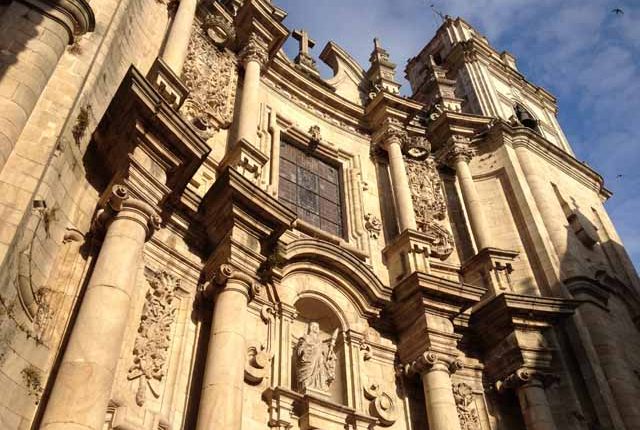
St Euphemia’s Church
Rúa Lamas Carvajal, 7, 32005
Opening hours according to worship
Former Jesuit school with a remarkable façade, archetype of Galician Baroque. Its concave shape, used to give greater monumentality, attracts attention.
Originally belonging to a former Jesuit school, since 1767 it is part of the diocese as a parish church, coinciding with the expulsion of the religious order from Spain. Its façade, made by Brother Plácido Iglesias, is an archetype of Galician Baroque, combining sumptuousness, the use of curved lines and the play of light with the most typical details of Galician art: the use of granite, the giant order of columns, pinnacles or pediments with cross. Especially striking is its concave shape, a possible resource for greater monumentality despite the narrowness of the street, as St Euphemia’s Square is modern and subsequent to the church.
The second largest church in the city, whose façade is a magnificent example of Galician Baroque.
The works began in the mid-17th century by private foundation, but its façade was not completed until a century later. Vaults and dome are from the 19th century and in the 20th century the church is completed with the sculpture that adorns the central niche, the statue of St Euphemia, head of the parish and a saint of great devotion in the city. The figure was designed by Xosé Cid and dates from 1985, while the bell tower is from 1989. After the Cathedral, it is the second largest church of Ourense.
The interior, very austere, has a Latin cross floor with three longitudinal naves, being lower the ones on the sides. A large Baroque altar presides over the church with the Christ of Hope in the centre (18th century).
The annex building on the right was built as a school for grammar studies; it has later been a secondary school, a museum, a seminary and currently a priestly residence.
St Euphemia in Ourense
According to tradition, the saint evangelized the area of Xurés and therefore suffered martyrdom under Emperor Hadrian. She was buried in the place now called Sierra de Santa Eufemia.
Centuries later, in 1060, a shepherdess discovered the tomb from which emerged a hand; she took her ring and when wearing it she lost her speech, which she recovered after returning the jewel to the saint. Then a voice saying that St Euphemia was buried there was heard. Thus began the disputes between the dioceses, since the place was halfway between Braga and Ourense. It was decided to put the body in a cart pulled by an ox and bury the saint in the place where it was directed. It was Ourense, therefore explaining the imortance of St Euphemia both in this the church and the Cathedral, where this story is evoked at a side altar of the main chapel.
Schedule
Opening hours according to worship

